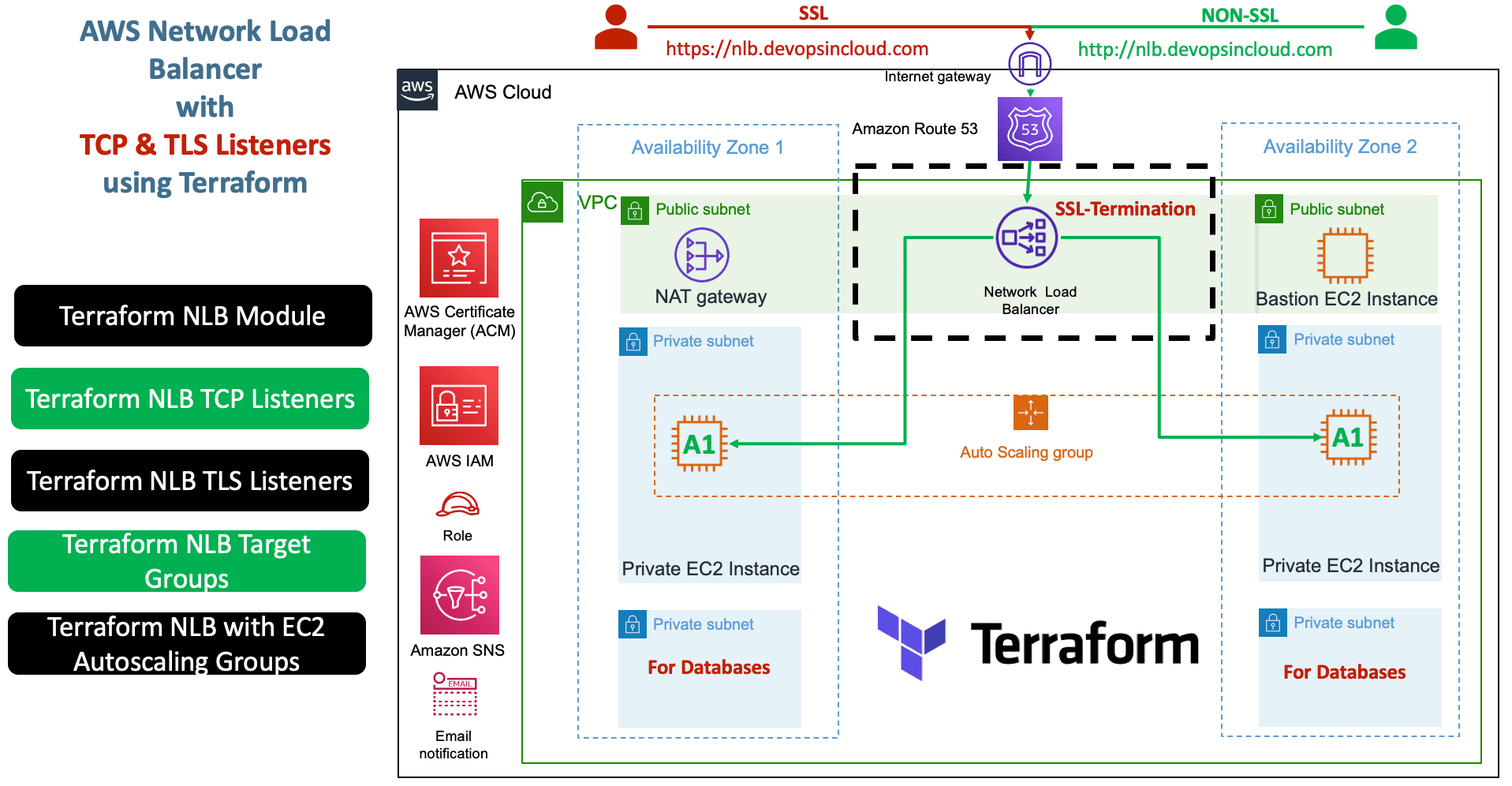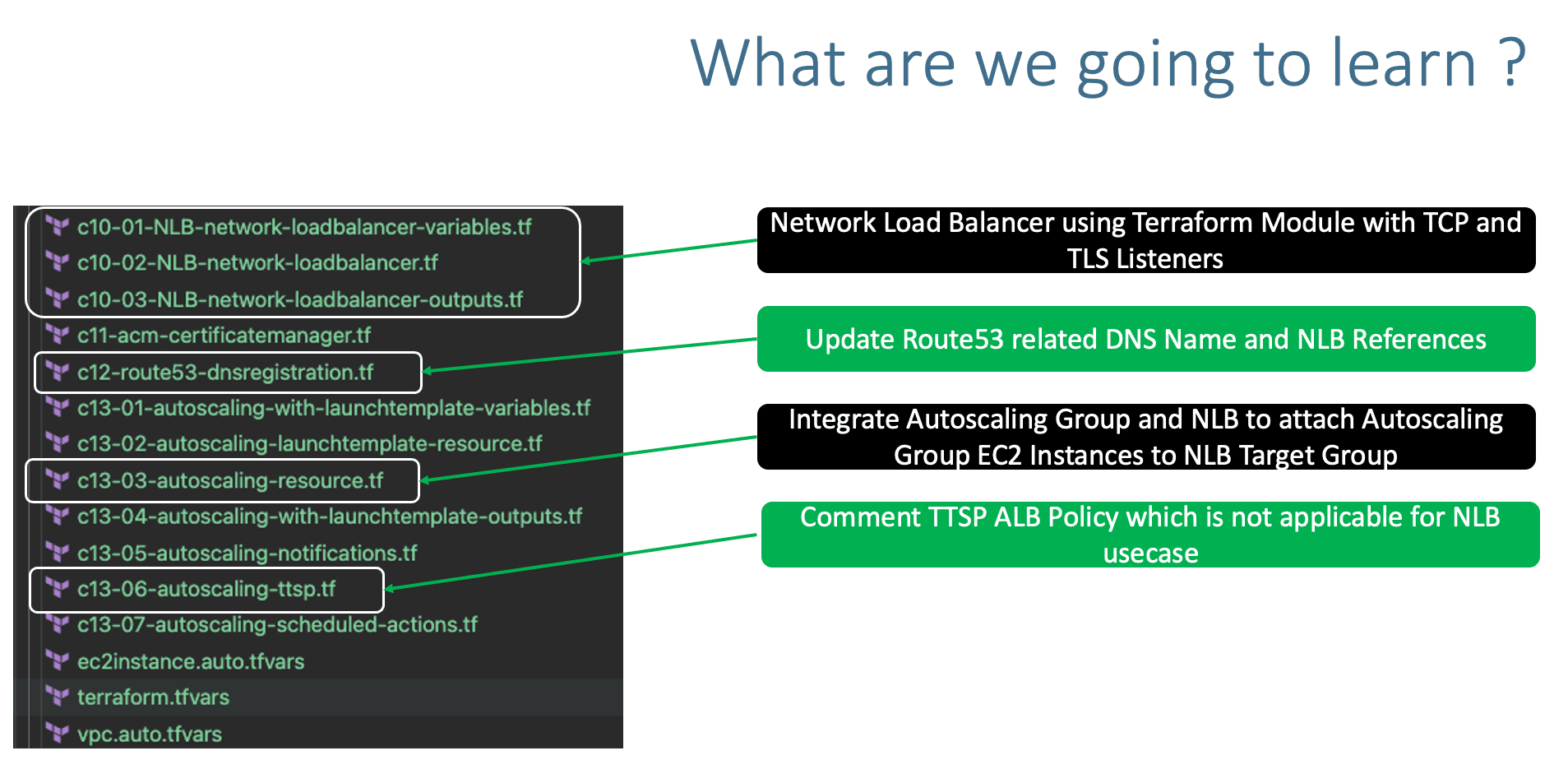Step-01: Introduction



Step-02: c5-04-securitygroup-privatesg.tf
- NLB requires private security group EC2 Instances to have the
ingress_cidr_blocks as 0.0.0.0/0
# Before
ingress_cidr_blocks = [module.vpc.vpc_cidr_block]
# After
ingress_cidr_blocks = ["0.0.0.0/0"] # Required for NLB
Step-03: c10-01-NLB-network-loadbalancer-variables.tf
- Place holder file for NLB variables.
Step-04: c10-02-NLB-network-loadbalancer.tf
# Terraform AWS Network Load Balancer (NLB)
module "nlb" {
source = "terraform-aws-modules/alb/aws"
version = "6.0.0"
name_prefix = "mynlb-"
#name = "nlb-basic"
load_balancer_type = "network"
vpc_id = module.vpc.vpc_id
subnets = module.vpc.public_subnets
#security_groups = [module.loadbalancer_sg.this_security_group_id] # Security Groups not supported for NLB
# TCP Listener
http_tcp_listeners = [
{
port = 80
protocol = "TCP"
target_group_index = 0
}
]
# TLS Listener
https_listeners = [
{
port = 443
protocol = "TLS"
certificate_arn = module.acm.acm_certificate_arn
target_group_index = 0
},
]
# Target Group
target_groups = [
{
name_prefix = "app1-"
backend_protocol = "TCP"
backend_port = 80
target_type = "instance"
deregistration_delay = 10
health_check = {
enabled = true
interval = 30
path = "/app1/index.html"
port = "traffic-port"
healthy_threshold = 3
unhealthy_threshold = 3
timeout = 6
}
},
]
tags = local.common_tags
}
Step-05: c10-03-NLB-network-loadbalancer-outputs.tf
# Terraform AWS Network Load Balancer (NLB) Outputs
output "lb_id" {
description = "The ID and ARN of the load balancer we created."
value = module.nlb.lb_id
}
output "lb_arn" {
description = "The ID and ARN of the load balancer we created."
value = module.nlb.lb_arn
}
output "lb_dns_name" {
description = "The DNS name of the load balancer."
value = module.nlb.lb_dns_name
}
output "lb_arn_suffix" {
description = "ARN suffix of our load balancer - can be used with CloudWatch."
value = module.nlb.lb_arn_suffix
}
output "lb_zone_id" {
description = "The zone_id of the load balancer to assist with creating DNS records."
value = module.nlb.lb_zone_id
}
output "http_tcp_listener_arns" {
description = "The ARN of the TCP and HTTP load balancer listeners created."
value = module.nlb.http_tcp_listener_arns
}
output "http_tcp_listener_ids" {
description = "The IDs of the TCP and HTTP load balancer listeners created."
value = module.nlb.http_tcp_listener_ids
}
output "https_listener_arns" {
description = "The ARNs of the HTTPS load balancer listeners created."
value = module.nlb.https_listener_arns
}
output "https_listener_ids" {
description = "The IDs of the load balancer listeners created."
value = module.nlb.https_listener_ids
}
output "target_group_arns" {
description = "ARNs of the target groups. Useful for passing to your Auto Scaling group."
value = module.nlb.target_group_arns
}
output "target_group_arn_suffixes" {
description = "ARN suffixes of our target groups - can be used with CloudWatch."
value = module.nlb.target_group_arn_suffixes
}
output "target_group_names" {
description = "Name of the target group. Useful for passing to your CodeDeploy Deployment Group."
value = module.nlb.target_group_names
}
Step-06: c12-route53-dnsregistration.tf
- Change-1: Update DNS Name
- Change-2: Update
alias name
- Change-3: Update
alias zone_id
# DNS Registration
resource "aws_route53_record" "apps_dns" {
zone_id = data.aws_route53_zone.mydomain.zone_id
name = "nlb1.devopsincloud.com"
type = "A"
alias {
name = module.nlb.lb_dns_name
zone_id = module.nlb.lb_zone_id
evaluate_target_health = true
}
}
Step-07: c13-03-autoscaling-resource.tf
- Change the module name for
target_group_arns to nlb
# Before
target_group_arns = module.alb.target_group_arns
# After
target_group_arns = module.nlb.target_group_arns
Step-08: c13-06-autoscaling-ttsp.tf
- Comment TTSP ALB policy which is not applicable to NLB
# TTS - Scaling Policy-2: Based on ALB Target Requests
# THIS POLICY IS SPECIFIC TO ALB and NOT APPLICABLE TO NLB
/*
resource "aws_autoscaling_policy" "alb_target_requests_greater_than_yy" {
name = "alb-target-requests-greater-than-yy"
policy_type = "TargetTrackingScaling" # Important Note: The policy type, either "SimpleScaling", "StepScaling" or "TargetTrackingScaling". If this value isn't provided, AWS will default to "SimpleScaling."
autoscaling_group_name = aws_autoscaling_group.my_asg.id
estimated_instance_warmup = 120 # defaults to ASG default cooldown 300 seconds if not set
# Number of requests > 10 completed per target in an Application Load Balancer target group.
target_tracking_configuration {
predefined_metric_specification {
predefined_metric_type = "ALBRequestCountPerTarget"
resource_label = "${module.alb.lb_arn_suffix}/${module.alb.target_group_arn_suffixes[0]}"
}
target_value = 10.0
}
}
*/
# Terraform Initialize
terraform init
# Terrafom Validate
terraform validate
# Terraform Plan
terraform plan
# Terraform Apply
terraform apply -auto-approve
Step-10: Verify the AWS resources created
- Confirm SNS Subscription in your email
- Verify EC2 Instances
- Verify Launch Templates (High Level)
- Verify Autoscaling Group (High Level)
- Verify Network Load Balancer
- TCP Listener
- TLS Listener
- Verify Network Load Balancer Target Group
- Health Checks - both nodes should be healthy
- Access and Test
# Access and Test with Port 80 - TCP Listener
http://nlb.devopsincloud.com
http://nlb.devopsincloud.com/app1/index.html
http://nlb.devopsincloud.com/app1/metadata.html
# Access and Test with Port 443 - TLS Listener
https://nlb.devopsincloud.com
https://nlb.devopsincloud.com/app1/index.html
https://nlb.devopsincloud.com/app1/metadata.html
Step-11: Clean-Up
# Terraform Destroy
terraform destroy -auto-approve
# Clean-Up Files
rm -rf .terraform*
rm -rf terraform.tfstate*
References
-Complete NLB - Example


